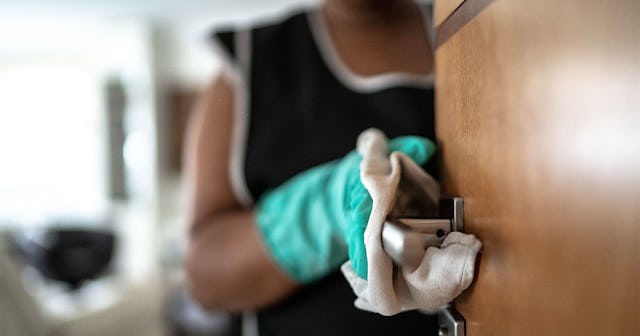Disinfecting Surfaces Might Not Be Worth It In Battle Against COVID

Scientists are now saying that our energy is better focused on the possibility of airborne transmission by avoiding crowded spaces and wearing masks
Early in the pandemic, disinfectant cleaners and paper towels flew off the shelves as Americans panicked about how best to avoid becoming infected with COVID-19. If my grocery stores and local Target are any indication, folks are still stocking up on cleaners in an effort to combat the deadly virus. Now, scientists are saying that all that wiping down of surfaces might not be worth the effort in trying to stay COVID-free.
As the pandemic has stretched on (and on and on because people are selfish and refuse to take simple precautions to keep their community safe but that’s a whole other story), science has learned new things about this novel virus. According to Rutgers University microbiologist Emanuel Goldman (via NPR), the risk of getting infected from touching a surface contaminated by the virus (after someone with COVID coughs, sneezes, or talks loudly) is low.
“In hospitals, surfaces have been tested near COVID-19 patients, and no infectious virus can be identified,” Goldman says.
In other words, all the frantic scrubbing some of us have performed for the last 10 months is likely not necessary when it comes to preventing transmission. In fact, what is found on surfaces where COVID droplets have fallen is a little thing called viral RNA, which according to Goldman, is akin to “the corpse of the virus.” In layman’s terms, it’s what’s left after the actual virus dies.
“They don’t find infectious virus, and that’s because the virus is very fragile in the environment — it decays very quickly,” Goldman says.
However, no need to feel silly or sheepish for the last several months of scrubbing everything with Clorox wipes. Early on in the pandemic, studies were showing we possibly had reason to clean frequently touched surfaces in order to prevent transmission of the virus. Linsey Marr, an engineering professor at Virginia Tech who studies airborne transmission of infectious disease, says it was thought that transmission of the virus could occur if an infected person coughed or sneezed on a surface and “you would get the disease by touching those surfaces and then transferring the virus into your eyes, nose or mouth.”
Now, Marr says all that disinfecting was likely “overkill.” After months of research, she says, “all the evidence points toward breathing in the virus from the air as being the most important route of transmission.”
Apparently, the early research was relying on super clean laboratory conditions that used much larger quantities of the virus than a real-life scenario would involve. Dr. Kevin Fennelly, a respiratory infection specialist with the National Institutes of Health, says there is no evidence to support constantly wiping down surfaces.
“When you see people doing spray disinfection of streets and sidewalks and walls and subways, I just don’t know of any data that supports the fact that we’re getting infected from viruses that are jumping up from the sidewalk,” he says.
Marr concurs saying, “Instead of paying so much attention to cleaning surfaces, we might be better off paying attention to cleaning the air, given the finite amount of time and resources.”
Fennelly also agrees noting that energy would be better spent figuring out how to prevent airborne transmission in indoor public spaces. “Why aren’t we doing more to figure out ways to ventilate those areas?” he asks. “It would be better to use ultraviolet germicidal irradiation, which we know can kill these viruses in the air.”
Bottom line? It’s still extremely important to avoid crowds, wear a mask, and limit the time spent indoors with folks not from your own household. So maybe now I can stop panicking when I see that Target’s cleaning product aisle is still bare bones.
This article was originally published on